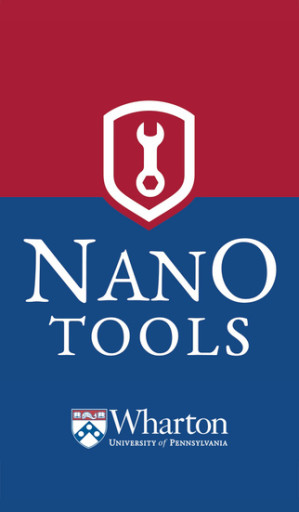
Wharton Nano Tool App Now Available
Wharton Executive Education is pleased to now offer all Nano Tools in an app format on the Apple App Store. The Android version is coming soon.
The app will allow you to filter according to date, topic, author, and keyword. It will also allow you to mark a tool you find interesting as a favorite and share it with friends and colleagues on social media such as Facebook, Linkedin and Twitter.
Wharton NanoTools – University of Pennsylvania
Compatibility: Compatibility: Requires iOS 8.0 or later. Compatible with iPhone, iPad, and iPod touch.
Nano Tool: Avoiding Social Media Minefields
 Contributor: Nancy Rothbard, PhD, David Pottruck Professor of Management, The Wharton School.
Contributor: Nancy Rothbard, PhD, David Pottruck Professor of Management, The Wharton School.
Nano Tools for Leaders® are fast, effective leadership tools that you can learn and start using in less than 15 minutes — with the potential to significantly impact your success as a leader and the engagement and productivity of the people you lead.
The Goal:
Choose a deliberate social media strategy that builds your professional reputation and enhances work relationships.
Nano Tool:
Thanks to social media, we now have many channels for interacting with the people we work with. But unlike face-to-face communication, social media doesn’t give us all the clues we need (such as facial expressions and body language) to help us tailor our message in cyberspace. Wharton research identifies four strategies for managing both what we communicate and
who will see it, each of which has its own set of consequences for how we are respected and liked at work. They range from being open and authentic, freely sharing many types of information, to creating self-enhancing content that gets shared with select audiences.
Before you choose a strategy, determine your goals for social media. Do you want to express yourself or impress others? Do you want to let everyone in on everything you’re doing, or do you want to be more aware of your professional reputation and how you are perceived by others? Decide how much, or how little, impression management matters to you. 
Then, assess your current social media strategy (or lack thereof) and its fit with your professional context. For example, in Law, the norm is that lawyers should not be connected with judges. If you work at a technology start-up company, the norm and the culture may be that everyone is connected via online chats, Facebook, and Instagram, and that’s how you interact with one another. Be aware of both your personal preferences and your environment, and how the two fit together.
Finally, assess your current strategy and its ability to help you accomplish your goals. Instead of waiting for a potential problem, be ready to adjust your strategy if it poses potential risks or if another strategy would help you reach your goals more effectively.
Action Steps:
These four strategies are archetypes; they can be used both exclusively and combined as hybrids.
- Open strategy: connect to anyone and everyone, and post anything and everything. This is the strategy of authenticity, openness, of trying to connect broadly and fully. It can make you well liked by some people, but average feelings of respect and liking among work colleagues may decrease. How to do it: connect with people broadly; post both positive and negative information; and allow others to freely comment on your posts.
- Content Strategy: limit the audience who you are conferring with [by choosing not to friend people from certain areas of your life, such as co-workers.] This strategy also uses authenticity: after carefully limiting your audience to friends, and excluding co-workers or clients, you can fully express the good, bad, and ugly. It typically allows you to preserve the respect of people you work with, but won’t help you enhance your relationships with them since they don’t learn more about you and your world. How to do it: ignore or deny friend requests made by professional
contacts; segment your online audiences, using different platforms for different groups, perhaps LinkedIn for work friends, and FaceBook for personal friends; make sure your personal profiles are unsearchable by using nicknames or aliases. Also make sure that your friends are all true friends who won’t re-post your photos or words to a more public venue. - Custom Strategy: connect to multiple audiences, but carefully manage what gets seen by which audience. This is a much more difficult strategy to manage, requiring some technologically sophisticated skills. It allows broad connections and authenticity to a chosen audience while curating what other audiences can see. The custom strategy offers the greatest ability to maximize both respect and liking, but it’s not easy to do. And if you make a mistake, it can backlash because people realize that you’re actively managing what you post and what they see. How to do it:
maintain lists of friends who can access different content by using “smartlists” or tools such as Google Circles; or by setting up two or more unique accounts on a platform such as Twitter using different email addresses.
Skirting – and Stepping Into – the Minefield:
While many CEO’s are venturing into social media, some are more successful than others — no matter which strategy they choose. Here are two who are getting it right.
- General Motors’ CEO Mary Barra is relatively new to Facebook, where she clearly embraces the content strategy. A majority of posts are positive GM-related items, and the image she conveys is one of a leader who’s proud of her company, supportive of women’s issues (especially women in business).
- John Legere, CEO of T-Mobile, uses an open strategy on Twitter. In addition to sharing news about his company, he tweets about popular culture, sharing video clips of TV and music performers. He also routinely blasts competitors and engages in “Twitter Wars,” most recently with presidential candidate Donald Trump. He enjoys colorful language, which some of his nearly two million followers seem to embrace, but which bothers others.
An American author, businessman, and speaker Zig Ziglar said, “Some of us learn from other people’s mistakes, the rest of us have to be the other people.” To avoid the dangers of falling into that second category, here are a few examples of how social media blunders can instantly wipe out years of career success.
- A sergeant in the U.S. Marine Corps posted negative comments about the President on Facebook, calling him a “domestic enemy” and asserting that he would not follow President Obama’s orders. He apparently forgot about the Pentagon policy that limits the free speech rights of military members. His nine-year military career ended with an other-than-honorable discharge and the loss of most of his benefits.
- A vice president at clothing retailer J. Crew posted to Instagram a picture of himself and a colleague celebrating at a bar in New York, just hours after he told 175 employees they were laid off. He used hashtags referring to the book and movie series “The Hunger Games,” about a post-apocalyptic society where, televised, children fight to the death. The pictures went viral, and he was fired the next week.
- Greg Gopman, the CEO of the open innovation firm AngelHack, wrote a Facebook post about how the homeless, mentally ill, and other “degenerates” were ruining San Francisco. Despite apologies, a backlash grew on Facebook and Twitter. Gopman resigned.
Additional Resources:
- “When Worlds Collide in Cyberspace: How Boundary Work in Online Social Networks Impacts Professional Relationships,” Nancy Rothbard, Justin Berg, and Ariane Ollier-Malaterre (Academy of Management Review, 2013, Vol. 38 No. 4). Examines the different strategies people use to manage their social media communications, and how those approaches impact the level of respect and liking that professional colleagues have for them.
- “Social Media or Social Minefield? Surviving in the New Cyberspace Era.” Nancy Rothbard and Ariane Ollier-Malaterre. (Organizational Dynamics, Vol. 44, No. 1). Further examines these strategies and provides many organizational examples of the effects of these strategies.
- The Social Leader: Redefining Leadership for the Complex Social Age, Frank Guglielmo and Sudhanshu Palsule (Bibliomotion, 2014). Provides insights for leaders who want to connect with and lead today’s new generation of employees, and sidestep potentially costly mistakes.
- Nancy Rothbard is the academic director of The Leadership Edge: Strategies for the New Leader and Women’s Executive Leadership: Business Strategies for Success. She teaches in Advanced Management Program, Creating and Leading High-Performance Teams, and Leading Organizational Change.
ABOUT NANO TOOLS
Nano Tools for Leaders® was conceived and developed by Deb Giffen, MCC, Director of Innovative Learning Solutions at Wharton Executive Education. It is jointly sponsored by Wharton Executive Education and Wharton’s Center for Leadership and Change Management, Wharton Professor of Management Michael Useem, Director. Nano Tools Academic Director is Professor John Paul MacDuffie, Professor of Management at the Wharton School and Director of the Program on Vehicle and Mobility Innovation (PVMI) at Wharton’s Mack Institute for Innovation Management.
See more at: Executive Education


